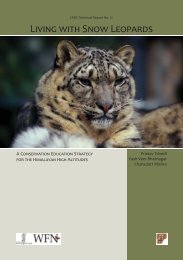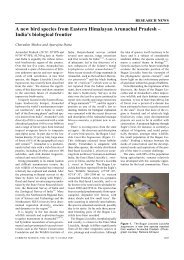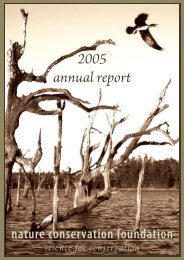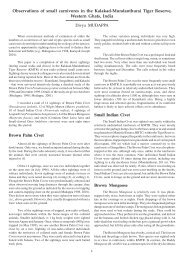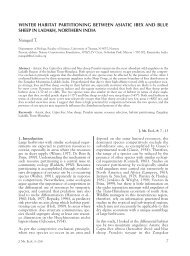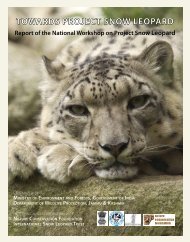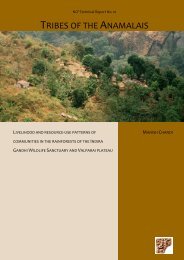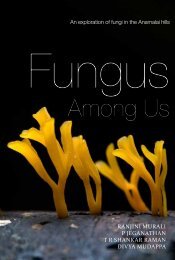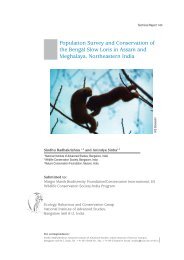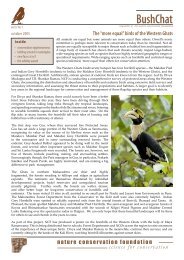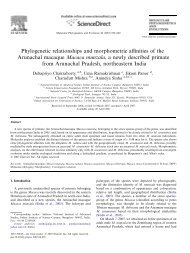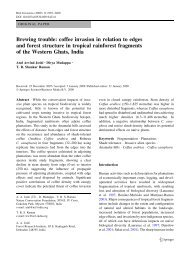2006-7 annual report - Nature Conservation Foundation
2006-7 annual report - Nature Conservation Foundation
2006-7 annual report - Nature Conservation Foundation
Create successful ePaper yourself
Turn your PDF publications into a flip-book with our unique Google optimized e-Paper software.
in determining levels of hunting, with animistic tribes<br />
hunting more than Buddhist tribes. Hunting of species<br />
such as musk deer, takin and black bear was common<br />
among the Meyor who knew the high market value of<br />
animal products such as musk pods and bear gall bladder<br />
and <strong>report</strong>ed selling these in towns.<br />
The number of active hunters and levels of hunting<br />
were higher in remote villages compared to villages<br />
that had road access and were closer to towns. Remote<br />
villages have few alternate employment opportunities<br />
compared to villages closer to towns and people have<br />
more free time to go hunting. The level of awareness<br />
was low in the region except in Nishi villages around<br />
the Pakke Tiger Reserve (East Kameng) and among the<br />
Monpa in Tawang, where people were aware of wildlife<br />
laws against hunting and <strong>report</strong>ed lower levels of hunting.<br />
The survey also documented a variety of indigenous<br />
traps and snares, the economic value of animal species<br />
and products, the ritual significance and use of certain<br />
species and taboos related to hunting<br />
Linking rural energy and nature conservation in a tribal village in Arunachal Pradesh<br />
One village was selected last year to provide alternate<br />
rural energy options (solar power for lighting, fuel-efficient<br />
cooking stoves and water heating gadgets) primarily<br />
to reduce the high dependence on forests for fuelwood<br />
and also to improve quality of life for the villagers.<br />
This has generated tremendous goodwill among the villagers<br />
and they reiterated their no-hunting pledges in<br />
meetings this year. The project has been approved by<br />
the Department of Science & Technology and work is<br />
expected to commence later this year.<br />
Team<br />
• Project investigator: Aparajita Datta<br />
• Collaborators: Dr. Harini Nagendra, ATREE; Phupla Singpho, SEACOW; Dr. Uma Ramakrishnan, NCBS; Dr. M. D.<br />
Madhusudan, NCF; Nandita Hazarika, Ecosystems-India<br />
• Research Affiliates: Rohit Naniwadekar, M. O. Anand, Somajita Paul, Vena Kapoor, Meghna Krishadas, Jiffy James<br />
Vadakkan, Ambika Aiyadurai<br />
• Field staff: Late Taya Tayum, Narayan Mogar, Rasham Barra, Kumar Tayum (all in Pakke TR); Akhi Nathany,<br />
Duchaye Yobin, Ngwa-akhi Yobin, Shekhar Subba, Khichaye Yobin (in Namdapha TR);<br />
• Other programme staff: Joshua Yobin, Phuyohey Yobin, Ngwashosey Yobin, Yumaphu Yobin, Selisa Yobin, Tsiyosa<br />
Yobin, Selifa Yobin<br />
• Artwork: Maya Ramaswamy<br />
• Design and Production: Pavithra Sankaran<br />
Funding agencies<br />
• Rufford <strong>Foundation</strong>, UK<br />
• Ford <strong>Foundation</strong>, New Delhi<br />
• Disney Wildlife <strong>Conservation</strong> Fund, USA (Wildlife <strong>Conservation</strong> Society, USA)<br />
• Katha, New Delhi<br />
• Individual donors: Nicholas Thompson, Ravi Subramanian<br />
22<br />
<strong>annual</strong><br />
<strong>report</strong>



